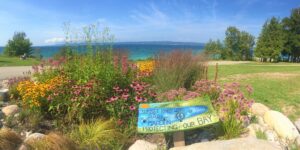The next time it rains, watch the water run off your roof, across your driveway, and down the street. Everywhere you go, water is on its way to the nearest stream, lake, river, or wetland. Some of the rain evaporates back into the air, some rain soaks into the ground, and some rain travels over the surface of the land.
What is Green Infrastructure, or Low Impact Development (LID)?
LID is an approach to land development (or redevelopment) that works with nature to manage stormwater as close to its source as possible.
The goal of LID is to reduce runoff and to mimic a site’s predevelopment hydrology by infiltrating, filtering, storing, evaporating, and detaining stormwater runoff. LID employs principles such as preserving and recreating natural landscape features and minimizing imperviousness to create functional and appealing site drainage that treats stormwater as a resource, rather than a waste product.

LID is also known as:
• Green Infrastructure
• Conservation Site Design
• Sustainable Stormwater Management
LID is one of many strategies and techniques used to counteract the impact of development. Many of the strategies have things in common and a few of the terms have been used interchangeably, but each may have a different frame that sets it apart from the others.
By implementing LID principles and practices, water can be managed in a way that reduces the effects of developed areas and promotes the natural movement of water in an ecosystem or watershed. Applied on a broad scale, LID can maintain or restore a watershed’s hydrologic and ecological functions and provide numerous other environmental, economic, and social benefits.
LID Benefits
LID offers a number of advantages over traditional, engineered stormwater drainage approaches, including:
- Addresses stormwater at its source
LID practices seek to manage rainfall where it falls, thereby reducing or eliminating the need for detention ponds and flood controls. - Promotes groundwater recharge
Many LID techniques allow stormwater to infiltrate the earth, thereby recharging groundwater aquifers and providing baseflow to streams during dry weather. The stormwater, cooled as it flows underground, helps keep stream
temperatures low. - Allows for more flexible site layouts
Whereas traditional stormwater management required large stormwater ponds that consume valuable real estate, the small-scale, dispersed nature of LID practices means that designers can include stormwater management in a variety of open spaces and smaller landscaped areas. - Preserves streams and watersheds
Because LID practices infiltrate rainfall and prevent runoff, they reduce both pollutant loads and streambank erosion associated with peak flows. - Enhances aesthetics and public access/use
Well-designed vegetated practices, such as rain gardens, can provide a visual amenity, particularly when compared to hardened drainage infrastructure such as pipes, curbs, gutters, and concrete-lined channels. Some practices can double as park space, offering recreational amenities. - Reduces costs
A common myth is that LID costs more than traditional stormwater management, but case studies have shown the opposite to be true. Savings can arise from the reduced amount of pipes, asphalt, detention basins or other infrastructure needed to handle runoff, reduced energy costs, and increases in developable land area, which otherwise would not have been available had traditional stormwater management approaches been employed.
Nature-Based Stormwater Solutions: Principles & Practices

Rain Gardens
What is a Rain Garden?On the surface, a rain garden looks like an attractive garden. It may support

Fertilizing Tips for Shoreline Properties
What does fertilizer have to do with our lakes and streams?Nutrients are elements or compounds essential for life.

Green Roofs
A green roof is a low-maintenance vegetated roof system that reduces stormwater runoff by absorbing and retaining the

Permeable Pavers
Porous or permeable pavement surfaces are suited for parking lots, low traffic residential streets, driveways, and sidewalks. The porous

Northern Michigan Native Plants
When selecting plants for your yard and garden, why not go native?Consider using plants that naturally grow in

Rain Barrels
If you want to capture water naturally from your roof top for use at a later, drier date,

Stormwater Glossary
Stormwater Glossary Stormwater runoff is the result of precipitation that does not infiltrate into the soil. Rather, it

Mural Project Time Lapse
Let’s do the time warp again! Check out this time-lapse video of the mural springing to life, along with
Nature Based Stormwater Solution Projects

Bay View Rain Garden Initiative
The Bay View Association (BVA) of The United Methodist Church is a National Historic Landmark community founded in

North Central Michigan College Stormwater Wetland Restoration
Campus stormwater was not being filtered properly causing excess nutrients and sediment from campus stormwater.


